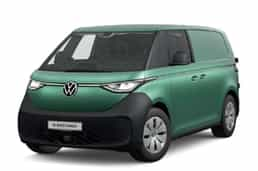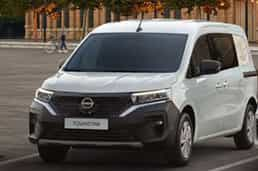Electric Vans / Electric Van Reviews / Top 5 Electric Vans By Range
So, you’ve decided that you’re ready to move over to an electric van. Great! But, which one do you go for? What do you need to look for to work out which is the best electric van for your operation? One of the most important factors for many is the range that the van can cover on a single charge. Our Van Expert Tim Cattlin takes a look at the top 5 electric vans by range, to help you make the right choice.
OK, before we start, there are a couple of caveats we need to get out of the way. Firstly – range isn’t everything. You may also need maximum payload, the biggest load volume or a van with a powerful motor so you might need to compromise here and there to get the best possible combination. The second thing to bear in mind is that the new electric van landscape is constantly changing, with new and improved products being launched regularly and so whilst this article is bang up to date right now, rest assured it won’t be before too long – I’ll endeavour to update it periodically though.
Without further ado, let’s crack on with the top 5 electric vans by range. All figures are the manufacturer’s WLTP Combined Cycle test results as published, and do bear in mind that these numbers are for comparison purposes only, and in real world driving with a load on I’d expect that you’ll rarely achieve them.
Some might say it’s not the prettiest van out there, but looks are subjective, and this van is an excellent tool for those needing to shift big volumes long distances without having to stop off and recharge. You’ll need to specify the largest battery pack (88.55kWh) to get the 185 mile range, but with a 210hp motor, the Maxus really does not hang about. Load volume is a cavernous 11.0 cubic meters, the payload is around 860kgs with this heavier battery, and the van can be charged overnight from your home wallbox in around 12 hours. It’s a very practical proposition all round.
Achieving just that one additional mile on a charge pops this fabulous (not so) little van into fourth place. Although Nissan, Mercedes-Benz and Renault market this van with slightly different exteriors and trim levels, underneath it’s essentially the same vehicle. Available in up to two lengths depending on the manufacturer the van offers 4.2 cubic meters of load volume and the 120hp electric motor is powered by a competent 44kWh battery pack. If you need a van with a decent payload but not masses of volume in the loadspace, this one might just work with its capacity of up to 764kgs, again, manufacturer and model dependant.
Ford (watch our video review) took a little while to enter the electric van market but, when it finally did, it certainly didn’t do things by halves. With a full range of body sizes and chassis cab models, there were none of the compromises made by some of its competitors when it comes to the number of derivatives available. To get this range, you’ll need to specify the L2H2 model, with a GVM of 3900kgs giving an excellent payload of 1408kgs (but benefiting from the government electric van derogation allowing drivers usually restricted to vans up to 3500kg to get behind the wheel), although other E-Transit models have similarly impressive ranges between charges. The load volume in this model is 9.5 cubic meters, but larger variants go up to 15.1cu/m.
You’ve a choice of two power outputs from the electric motor – one rated at 183hp, and the other at an incredible 269hp. I’ve spent quite some time behind the wheel of an E-Transit fitted with the ‘low’ power motor, and that was more than quick enough for me…
The UK’s best-selling electric van, the Vivaro Electric is joined in second place by its Stellantis Group siblings along with the Toyota, manufactured by the company under a commercial agreement. Once again, these vans are technically identical although there are some differences between them, particularly in terms of trim levels and standard equipment. The van is powered by a perfectly capable 136PS motor and to get this range, you’ll need to opt for the 75kWh battery pack which takes around 11 hours and 20 minutes to charge from flat using a 7kw home wallbox charger. The van is compatible with 100w DC public rapid chargers which will get you back to 80% of capacity in 45 minutes.
Medium vans combine a decent loadspace with a very useable payload and this one is no exception. Available in two body lengths payloads range right up to 1226kgs (manufacturer and model dependant) and the load volume in the L2 model is 6.1 cubic metres. This is another van that I’ve spent quite some time with and, it’s really impressive in pretty much every aspect.
Striding past all the opposition (for now, anyway) to take first place in our top 5 electric vans by range chart, this is the van that manages to look futuristic but retro at the same time. Although technically classed as a medium van, its dimensions and payload are perhaps more akin to a long version of a smaller van, for example the Caddy Maxi. You’ll get 592kgs of payload in the loadspace which, in its single body length (soon to be joined by a longer version) has a volume of 3.9 cubic metres.
Volkswagen (watch our video review) achieves this range by fitting the van with a big, 77kWh battery, the weight of which possibly explains the modest payload. The 204PS motor in such a light van makes for rapid progress and, once again in my experience with an example supplied by Volkswagen, the van is a pleasure, in fact, fun to drive. A real head turner, too.
Overall, a very worthy winner when it comes to range, but, let’s see what other manufacturers have up their sleeves…
 Ask for AvailabilityVw Id Buzz CargoId.buzz Cargo 150kW 77kWh Commerce Auto
Ask for AvailabilityVw Id Buzz CargoId.buzz Cargo 150kW 77kWh Commerce Auto
Go to deal
 Ask for AvailabilityNissan TownstarTownstar EV Van 45kWh Auto L1 90KW Acenta
Ask for AvailabilityNissan TownstarTownstar EV Van 45kWh Auto L1 90KW Acenta
Go to deal
 Ask for AvailabilityPeugeot ExpertExpert Van Electric 75kWh Pr/Pm
Ask for AvailabilityPeugeot ExpertExpert Van Electric 75kWh Pr/Pm
Go to deal
 Ask for AvailabilityFord TransitE-Transit 350 L2H2 68kWh 184ps Trend
Ask for AvailabilityFord TransitE-Transit 350 L2H2 68kWh 184ps Trend
Go to deal